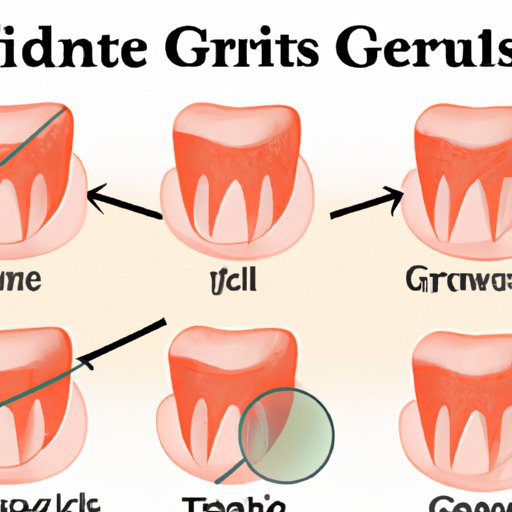I. Introduction
Gingivitis is a common gum disease that affects many individuals. The early stages of gingivitis are usually painless, and often go unnoticed. Gingivitis can cause inflammation, swelling, redness, and bleeding of the gums. If left untreated, gingivitis can develop into a more severe form of periodontal disease that can result in tooth loss and other health complications. The purpose of this article is to provide valuable information on how to cure gingivitis through simple, effective steps that promote better oral health.
II. Understanding Gingivitis: Causes and Symptoms
Gingivitis is a type of gum disease that results from the buildup of plaque on teeth. Plaque is a sticky substance that forms from food particles, bacteria, and saliva. Poor oral hygiene, smoking, hormonal changes, certain medications, and systemic diseases such as diabetes can increase the risk of gingivitis. The main symptoms of gingivitis include swollen, red, and bleeding gums, bad breath, and a receding gum line. If you experience any of these symptoms, it’s important to take immediate action to avoid the disease from progressing.
III. The Role of Oral Hygiene in Preventing and Curing Gingivitis
Oral hygiene plays a critical role in both the prevention and treatment of gingivitis. Good oral hygiene practices include brushing teeth twice daily using a fluoride toothpaste, flossing at least once a day, and using an antiseptic mouthwash regularly. This helps to remove plaque and bacteria from the teeth and gums, preventing gingivitis from developing. However, it’s important to note that certain mistakes while maintaining oral hygiene can actually worsen gingivitis. For instance, brushing too hard or using a hard-bristled toothbrush can damage gums, leading to further inflammation.
IV. The Power of a Healthy Diet in Curing Gingivitis
A healthy diet is crucial to promoting dental health and preventing gingivitis. A diet rich in vitamin C, vitamin D, calcium, and other essential nutrients will help strengthen teeth and gums, reducing the risk of gum disease. Foods that promote good dental health include leafy greens, fruits, dairy products, and lean proteins. In contrast, sugary and acidic foods such as candy, soda, and citrus fruits can damage teeth and gums, increasing the risk of gingivitis.
V. A Comprehensive Guide to Mouthwash for Gingivitis
Mouthwash can be a beneficial tool in the prevention and treatment of gingivitis. There are several types of mouthwash available on the market, including fluoride, antibacterial, and antiseptic mouthwash. The best mouthwash for gingivitis is typically an antiseptic mouthwash that contains chlorhexidine, as it reduces plaque formation, kills bacteria, and promotes healing of oral tissues. It’s important to use mouthwash in conjunction with proper oral hygiene practices for optimal results.
VI. The Importance of Regular Dental Visits in Managing and Preventing Gingivitis
Regular dental checkups are essential for maintaining oral health and preventing the onset of gingivitis. A dentist can help to detect early signs of gum disease before it progresses, as well as give advice on proper oral hygiene techniques to manage or prevent gingivitis. Dental procedures such as scaling and root planing can help to treat gingivitis and other gum diseases. In addition to dentists, dental hygienists also play a key role in preventive dental care, as they help patients maintain oral hygiene and prevent gum diseases.
VII. An Overview of Natural Remedies for Gingivitis
There are a variety of natural remedies that can help to prevent and treat gingivitis, including home remedies and herbal remedies. Home remedies for gingivitis include saltwater rinse, hydrogen peroxide rinse, and oil pulling. Herbal remedies such as aloe vera gel, tea tree oil, and chamomile can help to reduce inflammation and promote healing of the gums. It’s important to note that natural remedies should be used with caution and under the guidance of a dental professional, as some may have adverse effects or interact with medications.

VIII. Knowing When to Seek Professional Treatment for Gingivitis
While in many cases, gingivitis can be managed and treated from home, it’s important to know when to seek professional dental care. Signs that indicate it’s time to seek professional treatment include persistent swelling, pain, and bleeding of the gums, as well as loose teeth, and bad breath. Professional dental treatment typically involves procedures such as scaling and root planing, and in more severe cases, surgery or antibiotics may be required. While self-treatment may be less expensive, professional dental care may provide better results, faster healing, and better prevention of further gum disease.
IX. Conclusion
Overall, gingivitis is a manageable condition that can be both prevented and treated through a combination of healthy oral hygiene practices, a healthy diet, regular dental visits, and effective treatment methods. It’s important to be aware of the causes and symptoms of gingivitis and to take action at the early stages to avoid further complications. By following the tips in this article, you can maintain healthy gums and reduce your risk of developing gingivitis.
Remember, prevention is always better than cure! As such, it’s crucial to maintain good oral hygiene practices and a healthy lifestyle to avoid the development of gingivitis and other gum diseases. And if you do experience any symptoms suggestive of gum disease, don’t hesitate to seek professional dental care as soon as possible. With the right care and attention, you can enjoy a healthy, beautiful smile for years to come.
